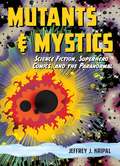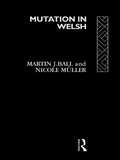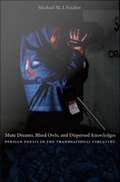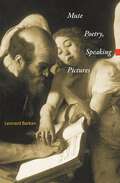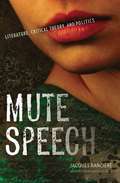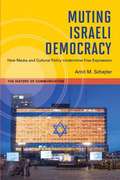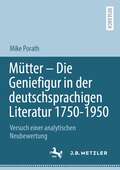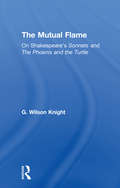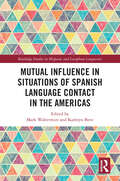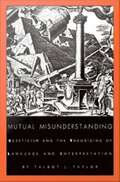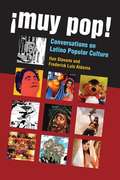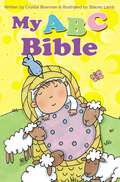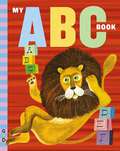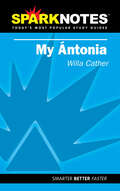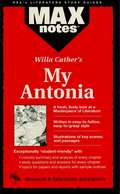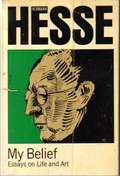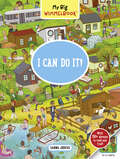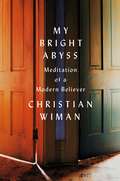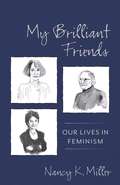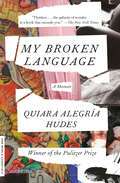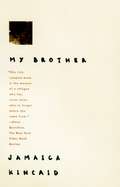- Table View
- List View
Mutants & Mystics: Science Fiction, Superhero Comics, and the Paranormal
by Jeffrey J. KripalIn many ways, twentieth-century America was the land of superheroes and science fiction. From Superman and Batman to the Fantastic Four and the X-Men, these pop-culture juggernauts, with their "powers and abilities far beyond those of mortal men," thrilled readers and audiences—and simultaneously embodied a host of our dreams and fears about modern life and the onrushing future. But that's just scratching the surface, says Jeffrey Kripal. In Mutants and Mystics, Kripal offers a brilliantly insightful account of how comic book heroes have helped their creators and fans alike explore and express a wealth of paranormal experiences ignored by mainstream science. Delving deeply into the work of major figures in the field—from Jack Kirby’s cosmic superhero sagas and Philip K. Dick’s futuristic head-trips to Alan Moore’s sex magic and Whitley Strieber’s communion with visitors—Kripal shows how creators turned to science fiction to convey the reality of the inexplicable and the paranormal they experienced in their lives. Expanded consciousness found its language in the metaphors of sci-fi—incredible powers, unprecedented mutations, time-loops and vast intergalactic intelligences—and the deeper influences of mythology and religion that these in turn drew from; the wildly creative work that followed caught the imaginations of millions. Moving deftly from Cold War science and Fredric Wertham's anticomics crusade to gnostic revelation and alien abduction, Kripal spins out a hidden history of American culture, rich with mythical themes and shot through with an awareness that there are other realities far beyond our everyday understanding. A bravura performance, beautifully illustrated in full color throughout and brimming over with incredible personal stories, Mutants and Mystics is that rarest of things: a book that is guaranteed to broaden—and maybe even blow—your mind.
Mutation in Welsh
by Martin J. Ball Nicole MüllerFirst published in 2002. Routledge is an imprint of Taylor & Francis, an informa company.
Mute Dreams, Blind Owls, and Dispersed Knowledges: Persian Poesis in the Transnational Circuitry
by Michael M. J. FischerOver the past decade Iranian films have received enormous international attention, garnering both critical praise and popular success. Combining his extensive ethnographic experience in Iran and his broad command of critical theory, Michael M. J. Fischer argues that the widespread appeal of Iranian cinema is based in a poetics that speaks not only to Iran's domestic cultural politics but also to the more general ethical dilemmas of a world simultaneously torn apart and pushed together. Approaching film as a tool for anthropological analysis, he illuminates how Iranian filmmakers have incorporated and remade the rich traditions of oral, literary, and visual media in Persian culture. Fischer reveals how the distinctive expressive idiom emerging in contemporary Iranian film reworks Persian imagery that has itself been in dialogue with other cultures since the time of Zoroaster and ancient Greece. He examines a range of narrative influences on this expressive idiom and imagery, including Zoroastrian ritual as it is practiced in Iran, North America, and India; the mythic stories, moral lessons, and historical figures written about in Iran's national epic, the Shahnameh; the dreamlike allegorical world of Persian surrealism exemplified in Sadeq Hedayat's 1939 novella The Blind Owl; and the politically charged films of the 1960s and 1970s. Fischer contends that by combining Persian traditions with cosmopolitan influences, contemporary Iranian filmmakers--many of whom studied in Europe and America--provide audiences around the world with new modes of accessing ethical and political experiences.
Mute Poetry, Speaking Pictures (Essays in the Arts)
by Leonard BarkanThe skirmish between painting and poetry—from Plato and Praxiteles to Rembrandt and ShakespeareWhy do painters sometimes wish they were poets—and why do poets sometimes wish they were painters? What happens when Rembrandt spells out Hebrew in the sky or Poussin spells out Latin on a tombstone? What happens when Virgil, Ovid, or Shakespeare suspend their plots to describe a fictitious painting? In Mute Poetry, Speaking Pictures, Leonard Barkan explores such questions as he examines the deliciously ambiguous history of the relationship between words and pictures, focusing on the period from antiquity to the Renaissance but offering insights that also have much to say about modern art and literature.The idea that a poem is like a picture has been a commonplace since at least ancient Greece, and writers and artists have frequently discussed poetry by discussing painting, and vice versa, but their efforts raise more questions than they answer. From Plutarch ("painting is mute poetry, poetry a speaking picture") to Horace ("as a picture, so a poem"), apparent clarity quickly leads to confusion about, for example, what qualities of pictures are being urged upon poets or how pictorial properties can be converted into poetical ones.The history of comparing and contrasting painting and poetry turns out to be partly a story of attempts to promote one medium at the expense of the other. At the same time, analogies between word and image have enabled writers and painters to think about and practice their craft. Ultimately, Barkan argues, this dialogue is an expression of desire: the painter longs for the rich signification of language while the poet yearns for the direct sensuousness of painting.
Mute Speech: Literature, Critical Theory, and Politics (New Directions in Critical Theory)
by Jacques RancièreJacques Rancière has continually unsettled political discourse, particularly through his questioning of aesthetic "distributions of the sensible," which configure the limits of what can be seen and said. Widely recognized as a seminal work in Rancière's corpus, the translation of which is long overdue, Mute Speech is an intellectual tour de force proposing a new framework for thinking about the history of art and literature. Rancière argues that our current notion of "literature" is a relatively recent creation, having first appeared in the wake of the French Revolution and with the rise of Romanticism. In its rejection of the system of representational hierarchies that had constituted belles-letters, "literature" is founded upon a radical equivalence in which all things are possible expressions of the life of a people. With an analysis reaching back to Plato, Aristotle, the German Romantics, Vico, and Cervantes and concluding with brilliant readings of Flaubert, Mallarmé, and Proust, Rancière demonstrates the uncontrollable democratic impulse lying at the heart of literature's still-vital capacity for reinvention.
Muting Israeli Democracy: How Media and Cultural Policy Undermine Free Expression
by Amit M. SchejterThe result of years of critical analysis of Israeli media law, this book argues that the laws governing Israeli electronic media are structured to limit the boundaries of public discourse. Amit M. Schejter posits the theory of a "mute democracy," one in which the media are designed to provide a platform for some voices to be heard over others. While Israel's institutions may be democratic, and while the effect of these policies may be limited, this book contends that free speech in Israel is institutionally muted to ensure the continued domination of the Jewish majority and its preferred interpretation of what Israel means as a Jewish-democratic state. Analyzing a wide range of legal documents recorded in Israel from 1961 to 2007, Muting Israeli Democracy demonstrates in scrupulous detail how law and policy are used to promote the hegemonic national culture through the constraints and obligations set on electronic media.
Mütter – Die Geniefigur in der deutschsprachigen Literatur 1750 – 1950: Versuch einer analytischen Neubewertung
by Mike PorathDas „Genie“ als etwas Gebärendes, Lebens-Verantwortendes – und damit Mütterliches? Auf dieser Grundlage wirft die Studie einen neuen Blick auf die Geniefigur in der deutschsprachigen Literatur von 1750-1950. Den Ausgangspunkt bildet eine Überlegung von Julia Kristeva, die um 2000 mit „Das weibliche Genie“ dem tradierten Männlichkeitsparadigma vom „Genie“ eine andere Sichtweise zur Seite stellt: Das „weibliche Genie“ ist in seiner Verkörperung als „Frau und Mutter“ dazu fähig, das menschliche Subjekt substanziell zu beeinflussen, ja zu verändern. „Genie“ wurde bisher nicht als Ausdrucksträger einer absoluten Subjektivität gesehen und man hat lange die geschlechtsspezifische Immanenz des Geniebegriffs unterschätzt. Die Untersuchung versucht diese Forschungslücken anhand der Analyse von 20 ausgewählten Kanontexten aus der deutschsprachigen Erzähl- und Dramenliteratur zu schließen. Darunter sind Texte, die für die Geniethematik bis heute maßgeblich sind, wie Goethes „Faust I“, E. T. A. Hoffmanns „Kater Murr“, Nietzsches „Zarathustra“, Musils „Mann ohne Eigenschaften“ oder Th. Manns „Doktor Faustus“, aber auch Texte, die bislang nicht mit „Genie“ verbunden worden sind, wie Klopstocks „Messias“, Jean Pauls „Schulmeisterlein Wutz“, Bonaventuras „Nachtwachen“, Jahnns „Fluß ohne Ufer“ oder Max Frischs „Homo faber“.
Mutual Flame - Wilson Knight V: On Shakespeare's Sonnets And The Phoenix And The Turtle
by Wilson KnightFirst Published in 2002. Routledge is an imprint of Taylor & Francis, an informa company.
Mutual Impressions: Writers from the Americas Reading One Another
by Ilan StavansIt is commonly assumed that the United States and Latin America, culturally so different, move artistically to very different rhythms. Also common is the assumption that, with rare exception, the literary figures on one side of the global North/South divide have had little interest in the work of their counterparts. With Mutual Impressions Ilan Stavans dispels these notions by showing how solid the bridges between writers and across borders have been, at least since the early days of this century, and how crucial they are likely to become as we enter the next millennium. Divided into symmetrical halves--South reading North and North reading South--the book presents essays by leading novelists, poets, and other writers that focus on the work of another literary figure from across the divide. Borges, for example, finds in Hawthorne the perfect precursor to his own interest in allegories; Katherine Anne Porter examines José Joaquín Fernández de Lizardi as a rascal whose picaresque views of life in The Itching Parrot served to launch the Latin American novel; Cortázar's study of the plots and style of Poe shows an affinity that left an indelible mark on the Argentine's short fiction; Susan Sontag views Machado de Assis as the ultimate mirror, a proto-postmodernist. With other essays by Thomas Pynchon, William H. Gass, John Updike, Gabriel García Márquez, Alejo Carpentier, John Barth, Robert Coover, Pedro Henríquez Ureña, Grace Paley, Juan Carlos Onetti, and Mark Strand, among others, Mutual Impressions offers a remarkable view of the connections that comprise a literary tradition of the Americas. It is a book that will surprise and enliven its readers as it informs and awakens in them a sense of wonder.Contributors. John Barth, José Bianco, Robert Bly, Jorge Luis Borges, Alejo Carpentier, Hiber Conteris, Robert Coover, Julio Cortázar, Ezequiel Martínez Estrada, Waldo Frank, Carlos Fuentes, William H. Gass, Nicolás Guillén, William Kennedy, Mario Vargas Llosa, Gabriel García Márquez, José Martí, Pablo Neruda, Victoria Ocampo, Juan Carlos Onetti, Grace Paley, Octavio Paz, Katherine Anne Porter, Thomas Pynchon, Kenneth Rexroth, Antonio Benítez Rojo, Barbara Probst Solomon, Susan Sontag, Ilan Stavans, Mark Strand, John Updike, Pedro Henríque Ureña, Derek Walcott, Paul West
Mutual Influence in Situations of Spanish Language Contact in the Americas (Routledge Studies in Hispanic and Lusophone Linguistics)
by Mark Waltermire and Kathryn BoveMutual Influence in Situations of Spanish Language Contact in the Americas focuses on the structural results of contact between Spanish and Maya, Quechua, Guaraní, Portuguese, and English in the Americas. This edited volume explores the various ways in which these languages affect the linguistic structure of Spanish in situations of language contact, and also how Spanish impacts their linguistic structure. Across ten chapters, this book offers a broad survey of bidirectional influence in Spanish contact situations both geographically (in the US Southwest, the Yucatán Peninsula, the Andean regions of Ecuador and Peru, and the Southern Cone) and structurally (in the areas of phonetics, phonology, morphosyntax, semantics, and pragmatics). By examining the potential structural effects that two languages have on one another, it provides a novel and more holistic perspective on mutual linguistic influence than that of previous work on language contact. The volume serves as a reference on mutual influence in bilingual language varieties and will be of interest to researchers, scholars and graduate students in Hispanic linguistics, and more broadly in language contact.
Mutual Misunderstanding: Scepticism and the Theorizing of Language and Interpretation
by Talbot J. TaylorDo others understand what we say or write? Do we understand them? Theorists of language and interpretation claim to be more concerned with questions about "what" we understand and "how" we understand, rather than with the logically prior question "whether" we understand each other. An affirmative answer to the latter question is apparently taken for granted. However, in Mutual Misunderstanding, Talbot J. Taylor shows that the sceptical doubts about communicational understanding do in fact have a profoundly important, if as yet unacknowledged, function in the construction of theories of language and interpretation. Mutual Misundertanding thus presents a strikingly original analysis of the rhetorical patterns underlying Western linguistic thought, as exemplified in the works of John Locke, Jacques Derrida, Gottlob Frege, Jonathan Culler, Noam Chomsky, Ferdinand de Saussure, H. Paul Grice, Michael Dummet, Stanley Fish, Alfred Schutz, Barbara Herrnstein Smith, Harold Garfinkel, and others. This analysis reveals how, by the combined effect of appeals to "commonsense" and anxieties about implications of relativism, scepticism has a determining role in the discursive development of a number of the intellectual disciplines making up the "human sciences" today, including critical theory, literary hermeneutics, philosophy of language and logic, communication theory, discourse and conversation analysis, pragmatics, stylistics, and linguistics. Consequently, this provocative study will be of value to readers from a wide variety of disciplinary backgrounds.
Mutual Othering: Islam, Modernity, and the Politics of Cross-Cultural Encounters in Pre-Colonial Moroccan and European Travel Writing
by Ahmed Idrissi AlamiFor the first time, readings of Moroccan travel writing in Arabic are juxtaposed with French and British writing about Morocco in a critical exploration of nineteenth-century concepts of modernity. Ahmed Idrissi Alami investigates the complex dynamics concerning colonial expansion, military conflict, and societal values. Mutual Othering sets out to rethink generally accepted concepts of European modernity by critically examining its production and contestation within a subaltern context in which the native other—in this case, religious scholars or imams accompanying political missions to Paris and London—presents aspects of European culture to elite members of the Moroccan imperial court. This work also connects the arguments of these texts to the rethinking of tradition and modernity, the rhetoric of reform, democracy and the Arab state, and the compatibility of Islam with the West and secular values in the post-9/11 world. The inclusion of citations in the original French and Arabic, alongside English translations, allows a range of readers to enjoy this critical addition to the fields of literature, travel writing, North African studies, history, international relations, and philosophy, as well as cultural and religious studies.
¡muy Pop!: Conversations On Latino Popular Culture
by Frederick Luis Aldama Ilan StavansAlthough investigations of Hispanic popular culture were approached for decades as part of folklore studies, in recent years scholarly explorations—of lucha libre, telenovelas, comic strips, comedy, baseball, the novela rosa and the detective novel, sci-fi, even advertising—have multiplied. What has been lacking is an overarching canvas that offers context for these studies, focusing on the crucial, framing questions: What is Hispanic pop culture? How does it change over time and from region to region? What is the relationship between highbrow and popular culture in the Hispanic world? Does it make sense to approach the whole Hispanic world as homogenized when understanding Hispanic popular culture? What are the differences between nations, classes, ethnic groups, religious communities, and so on? And what distinguishes Hispanic popular culture in the United States? In ¡Muy Pop!, Ilan Stavans and Frederick Luis Aldama carry on a sustained, free-flowing, book-length conversation about these questions and more, concentrating on a wide range of pop manifestations and analyzing them at length. In addition to making Hispanic popular culture visible to the first-time reader, ¡Muy Pop! sheds new light on the making and consuming of Hispanic pop culture for academics, specialists, and mainstream critics.
My ABC Bible
by Crystal BowmanBestselling author Crystal Bowman introduces preschoolers to the Bible and helps them learn their ABCs with My ABC Bible, a charming book filled with whimsical illustrations and simple, rhyming text.
My ABC Book (G&D Vintage)
by Grosset & DunlapDiscover a treasure trove of beautifully illustrated books with our new series, G+D Vintage! Featuring books from our Wonder Books line originally published in the 1940s, 50s, and 60s, there’s something for every reader in these timeless stories accompanied by classic illustrations.A is for airplane, M is for merry-go-round, and V is for vegetables! Kids will love learning their ABCs with this vintage-illustrated book full of animals, toys, and much more.
My ABC Prayers
by Crystal BowmanUsing rhythm and rhyme, My ABC Prayers uses the alphabet to teach children to pray in simple but meaningful ways. This book includes prayers of praise, thanksgiving, and petition, introducing young children to the many ways they can communicate with their heavenly Father. J is for JOYThank you, God, for times to giggle.For times of fun and JOY.Thank you for the happy daysYou give each girl and boy.
My Antonia (SparkNotes Literature Guide Series)
by SparkNotesMy Antonia (SparkNotes Literature Guide) by Willa Cather Making the reading experience fun! Created by Harvard students for students everywhere, SparkNotes is a new breed of study guide: smarter, better, faster. Geared to what today's students need to know, SparkNotes provides: *Chapter-by-chapter analysis *Explanations of key themes, motifs, and symbols *A review quiz and essay topicsLively and accessible, these guides are perfect for late-night studying and writing papers
My Antonia: MAXNotes Literature Guides
by Tim WenzellREA's MAXnotes for Willa Cather's My Antonia The MAXnotes features a comprehensive summary and analysis of My Antonia and a biography of Willa Cather. Places the events of the novel in historical context and discusses each section in detail. Includes study questions and answers along with topics for papers and sample outlines.
My Belief: Essays on Life and Art
by Hermann Hesse Theodore Ziolkowski Denver Lindley Ralph ManheimMy Belief: Essays on Life and Art is a collection of essays by Hermann Hesse. The essays, written between 1904 and 1961, were originally published in German, either individually or in various collections between 1951 and 1973. This collection in English was first published in 1976, edited by Theodore Ziolkowski.
My Big Wimmelbook® - I Can Do It!: A Look-and-find Book (kids Tell The Story) (My Big Wimmelbooks #0)
by Sarina JödickeKids will learn 150 phrases for everyday activities in our first wimmelbook with words! The My Big Wimmelbooks series is an effortless introduction to literacy that lets beginning readers ages 2 to 5 be the storyteller—with hours of seek-and-find hands-on learning. In these oversize board books, every page is bursting with life—and tons to discover! Children as young as two have a blast pointing out recognizable things—a blue tricycle, a hungry dog, a piggyback ride—while older kids can follow the star characters from page to page, telling their stories along the way. How? Wimmelbooks are virtually instruction-free, inviting kids to make their own way through the busy Wimmelworld they encounter, and to craft their own stories. First, you’re introduced to a unique cast of characters who are hidden in plain sight on the pages that follow. As you seek them out, each character’s storyline unfolds, but it’s up to kids to interpret the scenes and create stories they think fit. I Can Do It! brings in an extra educational element, with simple text on each spread that parents can read to children or children can try to sound out all by themselves. As the characters explore places like a neighborhood, school, city center, garden, and beachside carnival, short phrases call out what they’re doing. Can you find someone tying their shoes? Look at the friends playing hide-and-seek! Who’s going to sleep? This word-filled wimmelbook is sure to provide hours of imaginative fun—and an excellent introduction to literacy! About Wimmelbooks Wimmelbooks originated in Germany decades ago and have become a worldwide sensation with children (and adults!) everywhere. My Big Wimmelbooks is the first-ever English-language Wimmelbook series. Its books have been praised as “lively . . . and abounding with humor and detail” (WSJ) and likely to “make any parent’s heart sing” (NYT).
My Bright Abyss: Meditation Of A Modern Believer
by Christian WimanSeven years ago, Christian Wiman, a well-known poet and the editor of Poetry magazine, wrote a now-famous essay about having faith in the face of death. My Bright Abyss, composed in the difficult years since and completed in the wake of a bone marrow transplant, is a moving meditation on what a viable contemporary faith—responsive not only to modern thought and science but also to religious tradition—might look like. Joyful, sorrowful, and beautifully written, My Bright Abyss is destined to become a spiritual classic, useful not only to believers but to anyone whose experience of life and art seems at times to overbrim its boundaries. How do we answer this “burn of being”? Wiman asks. What might it mean for our lives—and for our deaths—if we acknowledge the “insistent, persistent ghost” that some of us call God? One of Publishers Weekly's Best Religion Books of 2013.
My Brilliant Friends: Our Lives in Feminism (Gender and Culture Series)
by Nancy K. MillerMy Brilliant Friends is a group biography of three women’s friendships forged in second-wave feminism. Poignant and politically charged, the book is a captivating personal account of the complexities of women’s bonds.Nancy K. Miller describes her friendships with three well-known scholars and literary critics: Carolyn Heilbrun, Diane Middlebrook, and Naomi Schor. Their relationships were simultaneously intimate and professional, emotional and intellectual, animated by the ferment of the women’s movement. Friendships like these sustained the generation of women whose entrance into male-dominated professions is still reshaping American society. The stories of their intertwined lives and books embody feminism’s belief in the political importance of personal experience. Reflecting on aging and loss, ambition and rivalry, competition and collaboration, Miller shows why and how friendship’s ties matter in the worlds of work and love. Inspired in part by the portraits of the intensely enmeshed lives in Elena Ferrante’s Neapolitan novels, My Brilliant Friends provides a passionate and timely vision of friendship between women.
My Broken Language: A Memoir
by Quiara Alegría HudesA Pulitzer Prize–winning playwright tells her lyrical story of coming of age against the backdrop of an ailing Philadelphia barrio, with her sprawling Puerto Rican family as a collective muse. &“Quiara Alegría Hudes is in her own league. Her sentences will take your breath away. How lucky we are to have her telling our stories.&”—Lin-Manuel Miranda, award-winning creator of Hamilton Quiara Alegría Hudes was the sharp-eyed girl on the stairs while her family danced in her grandmother&’s tight North Philly kitchen. She was awed by her aunts and uncles and cousins, but haunted by the secrets of the family and the unspoken, untold stories of the barrio—even as she tried to find her own voice in the sea of language around her, written and spoken, English and Spanish, bodies and books, Western art and sacred altars. Her family became her private pantheon, a gathering circle of powerful orisha-like women with tragic real-world wounds, and she vowed to tell their stories—but first she&’d have to get off the stairs and join the dance. She&’d have to find her language. Weaving together Hudes&’s love of books with the stories of her family, the lessons of North Philly with those of Yale, this is an inspired exploration of home, memory, and belonging—narrated by an obsessed girl who fought to become an artist so she could capture the world she loved in all its wild and delicate beauty.
My Brother
by Jamaica KincaidJamaica Kincaid's incantatory, poetic, and often shockingly frank recounting of her brother Devon Drew's life is also the story of her family on the island of Antigua, a constellation centered on the powerful, sometimes threatening figure of the writer's mother. Kincaid's unblinking record of a life that died too early speaks volumes about the difficult truths at the heart of all families.
